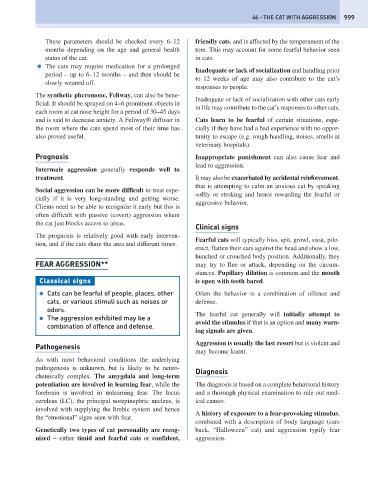Page 1007 - Problem-Based Feline Medicine
P. 1007
46 – THE CAT WITH AGGRESSION 999
These parameters should be checked every 6–12 friendly cats, and is affected by the temperament of the
months depending on the age and general health tom. This may account for some fearful behavior seen
status of the cat. in cats.
● The cats may require medication for a prolonged
Inadequate or lack of socialization and handling prior
period – up to 6–12 months – and then should be
to 12 weeks of age may also contribute to the cat’s
slowly weaned off.
responses to people.
The synthetic pheromone, Feliway, can also be bene-
Inadequate or lack of socialization with other cats early
ficial. It should be sprayed on 4–6 prominent objects in
in life may contribute to the cat’s responses to other cats.
each room at cat nose height for a period of 30–45 days
and is said to decrease anxiety. A Feliway® diffuser in Cats learn to be fearful of certain situations, espe-
the room where the cats spend most of their time has cially if they have had a bad experience with no oppor-
also proved useful. tunity to escape (e.g. rough handling, noises, smells at
veterinary hospitals).
Prognosis Inappropriate punishment can also cause fear and
lead to aggression.
Intermale aggression generally responds well to
treatment. It may also be exacerbated by accidental reinforcement,
that is attempting to calm an anxious cat by speaking
Social aggression can be more difficult to treat espe-
softly or stroking and hence rewarding the fearful or
cially if it is very long-standing and getting worse.
aggressive behavior.
Clients need to be able to recognize it early but this is
often difficult with passive (covert) aggression where
the cat just blocks access to areas.
Clinical signs
The prognosis is relatively good with early interven-
Fearful cats will typically hiss, spit, growl, swat, pilo-
tion, and if the cats share the area and different times.
erect, flatten their ears against the head and show a low,
hunched or crouched body position. Additionally, they
FEAR AGGRESSION** may try to flee or attack, depending on the circum-
stances. Pupillary dilation is common and the mouth
Classical signs is open with teeth bared.
● Cats can be fearful of people, places, other Often the behavior is a combination of offence and
cats, or various stimuli such as noises or defense.
odors.
The fearful cat generally will initially attempt to
● The aggression exhibited may be a
avoid the stimulus if that is an option and many warn-
combination of offence and defense.
ing signals are given.
Aggression is usually the last resort but is violent and
Pathogenesis
may become learnt.
As with most behavioral conditions the underlying
pathogenesis is unknown, but is likely to be neuro-
Diagnosis
chemically complex. The amygdala and long-term
potentiation are involved in learning fear, while the The diagnosis is based on a complete behavioral history
forebrain is involved in unlearning fear. The locus and a thorough physical examination to rule out med-
ceruleus (LC), the principal norepinephric nucleus, is ical causes.
involved with supplying the limbic system and hence
A history of exposure to a fear-provoking stimulus,
the “emotional” signs seen with fear.
combined with a description of body language (ears
Genetically two types of cat personality are recog- back, “Halloween” cat) and aggression typify fear
nized – either timid and fearful cats or confident, aggression.

